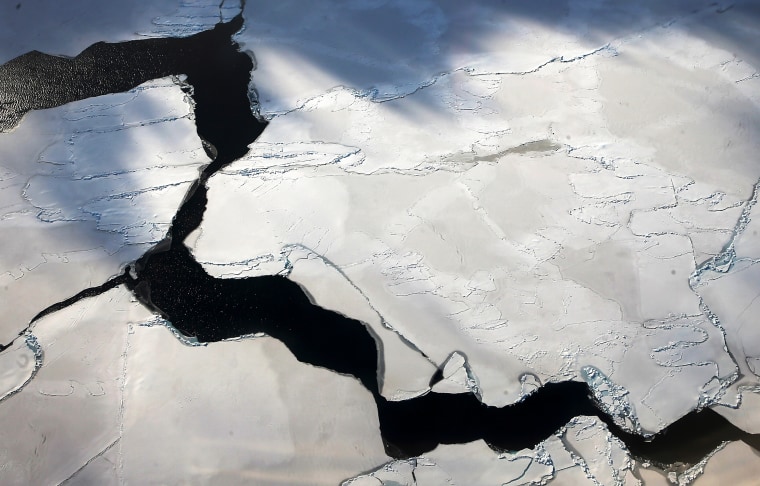The amount of ice floating in waters off Antarctica has declined significantly since 2014, a new study shows. But the same research — a detailed analysis of 40 years of satellite data about sea ice — shows that the amount of Antarctic sea ice grew unexpectedly for almost four decades before the steep decline, even as sea ice in the Arctic region declined.
The new findings represent a scientific puzzle.
“There’s a lot of interannual variability in both Arctic and Antarctic sea ice, but Arctic sea ice has been decreasing in extent since the late 1970s, which is consistent with what we’d expect,” said study author Claire Parkinson, a climatologist at NASA’s Goddard Space Flight Center in Greenbelt, Maryland. “What was happening in Antarctica could not be so easily explained.”
Researchers have long struggled to explain the unusual behavior of Antarctic sea ice, which forms when seawater surrounding the southernmost continent freezes in winter. Whereas Arctic sea ice has been in steady decline over the past four decades, the amount of Antarctic sea ice increased from 1979, when scientists first had access to routine satellite observations of the area, to 2014, when the ice began its retreat.
The study, published Monday in the journal Proceedings of the National Academy of Sciences, was based on data from the Nimbus 7 meteorological satellite, which NASA launched in 1978. It shows the stark contrast between Antarctica’s record high sea-ice coverage in 2014 and the record lows recorded in 2017.
“It was just three years later that we had a record low, which is quite a rapid shift,” Parkinson said. “The magnitude of that decrease from 2014 to 2017 was more than the decrease that has happened in the Arctic over more than 30 years.”
But what caused the initial expansion and subsequent speedy retreat remains a mystery. Researchers have some hypotheses, but so far there is no scientific consensus.
Some scientists link the puzzling reversal in Antarctic sea ice to the ozone hole over Antarctica, Parkinson said. During the 1980s and ’90s, heavy use of aerosol sprays, refrigerants and other products containing compounds known as chlorofluorocarbons thinned the ozone layer in Earth's atmosphere and allowed more warming ultraviolet rays from the sun to reach the planet’s surface. Chlorofluorcarbons were phased out as part of the 1987 Montreal Protocol, helping restore ozone levels and presumably cooling the ocean and helping raise levels of Antarctic sea ice.
Other researchers say the shifting levels of sea ice could represent natural climate patterns.
One such pattern is El Niño, which occurs when changes in the strength or direction of trade winds every two to seven years causes waters in the central and eastern Pacific Ocean to become unusually warm. Another is the so-called Interdecadal Pacific Oscillation, which every decade or two alters air pressure, sea temperatures and wind direction.
“When tropical Pacific sea surface temperatures are warmer than usual, there are shifts in precipitation and shifts in the pattern of winds driven from the tropics,” said Gerald Meehl, a senior scientist at the National Center for Atmospheric Research, who was not involved with the new study.
Atmospheric shifts tied to the Interdecadal Pacific Oscillation that lasted from 1999 to 2013 boosted winds at high southern latitudes around Antarctica during this time — a shift that could have reduced the extent of sea ice around Antarctica by pushing it northward. “You have this mechanism where the winds expand the ice out as far as the wind will blow it,” Meehl said.
From 2014 to 2016, the Interdecadal Pacific Oscillation shifted again, which may have had the opposite effect.
But scientists agreed that more research is needed to better understand the waxing and waning of sea ice.
“We’ve now got 40 years of data, so we can look more holistically at the interactions between the tropics and the polar regions, the ice and atmosphere,” said Julie Arblaster, an atmospheric scientist at Monash University in Melbourne, Australia, who was not involved with the new study.
Researchers are also keen to understand the impact of rising global temperatures on sea ice. Meehl said climate change has probably amplified natural shifts in sea ice levels but said more data and better climate models will be needed before scientists can fully understand the possible connection.
“We don’t have really long records in this region, which makes it difficult,” Arblaster said, adding that four decades actually represented a small window of time. “But the question of how climate change is interacting with natural variability is very much a question that we need to grapple with. So far our understanding is that there have been bouts of natural variability that leads to what we’ve seen, but the longer it goes on and the longer sea ice stays at record lows, the question of climate change has to come into this.”
Want more stories about the environment?
- Dozens of lakes discovered deep under the Greenland Ice Sheet
- This floating city concept is one way to cope with climate change
- 1 million species under threat of extinction because of humans, new report finds
SIGN UP FOR THE MACH NEWSLETTER AND FOLLOW NBC NEWS MACH ON TWITTER, FACEBOOK, AND INSTAGRAM.


